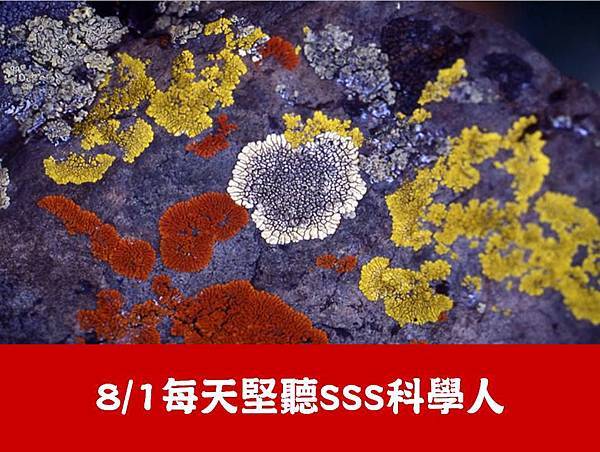
 今日主題:For Lichens, 3's Not a Crowd / 地衣含有多種成分--可能四五種
今日主題:For Lichens, 3's Not a Crowd / 地衣含有多種成分--可能四五種
 洪欣老師推薦:托福聽力最好的課外教材:60-Second Science
洪欣老師推薦:托福聽力最好的課外教材:60-Second Science
 康康精選托福會考的主題,堅持每天精聽一定會進步的哦!!
康康精選托福會考的主題,堅持每天精聽一定會進步的哦!!
 建議方法:
建議方法:
1. 先聽兩三遍 (不看文稿)
2. 再一句一句聽寫 (每句都要聽寫數遍,直到寫出85%以上的字)
3. 最後check文稿,看哪聽不出來,單字沒背過,還是發音不熟。
4. 堅持天天聽,就能每天進步哦。
 MP3音檔 (按右鍵可下載聽):喜歡的同學,幫忙推或按讚哦~~
MP3音檔 (按右鍵可下載聽):喜歡的同學,幫忙推或按讚哦~~
http://online1.tingclass.net/voaspe/…/20160725sa_science.mp3
 只有音檔怎夠,聽不懂地方,不用怕,康康幫你準備好中英文稿了:
只有音檔怎夠,聽不懂地方,不用怕,康康幫你準備好中英文稿了:
 中英文稿:
中英文稿:
Lichens. They’re probably the most common example of two organisms living in a symbiotic relationship. There’s a fungus and a photosynthesizing partner, like algae. It's a bond that was born, as they say, when "Alice Algae," took a "lichen" to "Freddie Fungus."
地衣——它們可能是兩種生物共生最常見的例子。地衣中包含一種真菌與藻類等進行光合作用的生物。這種聯繫是固有的,正如他們所說,當“愛麗絲藻類”與真菌共生,成為“地衣”。
But that simple description covered up a larger mystery: how could two different lichen species combine the same building blocks—same fungus, same algae—“and yet they look very different, have very different chemistry, and some of them even have distinctly different ecology."
但這簡單的描述掩蓋了一個更深奧的秘密:兩個不同的地衣物種如何結合同樣的成分——同樣的真菌和同樣的藻類。“並且,它們形狀不同,有著不同的化學成分,並且它們中的一些甚至有著截然不同的生態。”
Toby Spribille, an evolutionary biologist at the University of Montana, and the University of Graz in Austria.
Toby Spribille是蒙大拿大學和奧地利格拉茨大學的進化生物學家。
He and his colleagues studied two lichen species that fit that bill. Same underlying parts, different color and chemistry. They ground the lichens up, and then analyzed their RNA. What they expected to find was two genomes: one fungus, one alga. "And what we found was, at the end of a lot of analysis, what we had was three genomes, not two."
他與他的研究團隊對兩種符合這個要求的地衣進行了研究。這兩種地衣的成分基本相同,但顏色與化學成分不同。他們將地衣進行研磨,然後分析了它們的核糖核酸。“他們期望會發現兩個基因組:一個是真菌,另一個是海藻。但最後,在進行大量分析後,我們所發現的是三個基因組,不是兩個。”
The third genome was from a type of yeast. And the more yeast was present, the more yellowish—and more toxic—the lichen was. The study appears in the journal Science. [Toby Spribille et al., Basidiomycete yeasts in the cortex of ascomycete macrolichens]
第三個基因組來自於一種酵母。並且酵母成分越多,地衣顏色越淡黃,毒性也就越強。該項研究發表在科學雜誌上。
But how could scientists spend so many years studying these lichens—and still miss this crucial third species? Spribille says it could have been the type of genetic sequencing. Previous studies relied on DNA barcodes, which only sample some of the genome, to identify the underlying fungus and alga. Sort of like identifying the occupants of a completely dark room by shouting out a few names and seeing who answers.
但為什麼科學家們在對這些地衣研究這麼多年卻仍未發現這至關重要的第三物種?Spribille 表示這可能是由於基因測序的類型。先前的研究依賴於DNA條碼,但它只是這一組基因組中的部分樣本,用以識別潛在的真菌和藻類。這就像通過喊出幾個名字,看看誰作出回答,從而在一個完全黑暗的房間裡對人進行識別。
What Spribille did, instead, was just turn all the lights on, with whole genome sequencing, revealing the identity of all occupants, and in doing so, "we eliminated anything that required going in and calling out somebody's name so to speak."
相反,Spribille所做的只是打開房間內所有的燈,通過全基因組測序,揭示所有居住者的身份,並且通過這樣做,可以這麼說,我們不需要進入房間和喊出某人的名字。
As for whether some lichens might have four, five species? "I certainly wouldn't rule it out at this point." Because this study indicates lichens are truly more than the sum of their parts. Including, of course, the parts we still don't know about.
而對於是否某些地衣可能還有四個、五個物種?在這一點上,我當然不會排除這一可能性。因為這項研究表明事實上,地衣不僅僅是各部分的單純相加,還包括我們仍然不知道的成分。


 留言列表
留言列表
